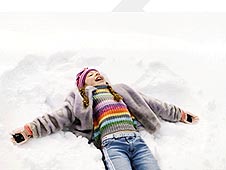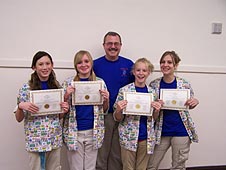Feature
Snow Day
01.03.08
Who Are NASA's Earth Explorers?
The elementary school student wondering how El Niño will affect tomorrow's weather. The scientist studying connections between ozone and climate change. And the farmer using satellite pictures to keep track of crops. All of these people are Earth Explorers -- they are all curious about the Earth system. This monthly series will introduce you to NASA Earth Explorers, young and old, with many backgrounds and interests.
Nominate an Earth Explorer!
Tell us about the Earth Explorers you know. We're looking for students, teachers, scientists and others who are working with NASA Earth science data and imagery to better understand our home planet. Send your nominations to Dan Stillman: dan_stillman@strategies.org.

Urban areas tend to get less snow than nearby rural areas. Image Credit: Microsoft Clipart
Even on a cold winter day, the words "snow day" bring a warm smile to kids of all ages. But some kids get more snow days than others. In fact, the number of snow days can vary greatly over a rather short distance.Students in some urban areas know the feeling all too well. At night, they might go to sleep with the possibility of snow in the forecast. Yet, come morning, the scene outside their window is mostly wet, not wintry. Meanwhile, in the nearby suburbs, the ground is covered in white.
Steve Frantz sees firsthand how the weather can change from one community to the next. He teaches science at Roswell Kent Middle School in Akron, Ohio. But he lives in a nearby rural area.
"There have been days when I have not been able to go to school because my county has been shut down [except for] emergency vehicles. But all is well in the city," Frantz said. "For many of my students, really bad winter weather is only something they see on TV, even though it may only be a few miles away."
Frantz was complaining in class one day about the lack of snow days. (Kids aren't the only ones who look forward to a day off!) His gripe gave four students an idea for a science project. The project has now earned them and Frantz a trip to South Africa next year.
Ashley, Katelyn, Julia and Elizabeth decided to study the impact of asphalt on the temperature of surrounding grass. They suspected that the larger amounts of asphalt found in urban areas were the reason for warmer temperatures and less snow.
To start the project, the students had to develop a research question and hypothesis. Next, they measured the grass temperature outside their school on five straight days, at the same time each day. For comparison, they obtained similar data for six nearby sites with varying land types. The sites included three high schools, one college and a research center.

From left to right: Ashley, Katelyn, Elizabeth, Julia, and Steve Frantz (back) are recognized at a recent school board meeting. Image Credit: Steve Frantz
How did they determine the type of land around each site? They used Google Earth and aerial photographs. These tools helped them figure out how much of the land was asphalt, natural cover or manmade structures.Graphing and analyzing the data came next. Then the students made a poster explaining their work and entered it into a state contest. After taking fourth place, they decided to aim even higher. They turned the poster into a research paper and submitted it to a national GLOBE contest. GLOBE stands for Global Learning and Observations to Benefit the Environment. It is a science and education activity for students in grades K-12. Participants take measurements of the atmosphere, land, water, and plant and animal life.
The girls did quite well in the national contest. They were one of five winning teams to be selected to attend the 2008 GLOBE Learning Expedition in Cape Town, South Africa. The event will bring together hundreds of students from all over the world to share projects and learn about each other's cultures.
Despite their success, the Roswell Kent students have faced challenges along the way. Early on, they discovered that one of the schools took temperature observations on the wrong type of surface. Also, the research results only partially supported their hypothesis -- that grass temperatures are affected by the amount of asphalt covering the surrounding area.
More data and a larger study are needed, the girls concluded. They learned that research sometimes turns up more questions than answers. "We had one question at first, but now we have many different questions," Julia said.
"We learned that science is really never-ending," Elizabeth added. "There (are) always things you can do to (revise your project)."
Related Resources
GLOBE →
Min/Max Thermometer Quiz →
Meet Previous Earth Explorers